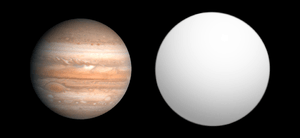SWEEPS-11
| Exoplanet | List of exoplanets | |
|---|---|---|
 | ||
| Parent star | ||
| Star | SWEEPS J175902.67−291153.5 | |
| Constellation | Sagittarius | |
| Right ascension | (α) | 17h 59m 02.67s |
| Declination | (δ) | −29° 11′ 53.5″ |
| Apparent magnitude | (mV) | 19.83 |
| Distance | 22000 ly (6600 pc) | |
| Orbital elements | ||
| Semi-major axis | (a) | 0.03 AU |
| Orbital period | (P) | 1.796 d |
| Inclination | (i) | >84° |
| Physical characteristics | ||
| Mass | (m) | 9.7±5.6 MJ |
| Radius | (r) | 1.13±0.21 RJ |
| Discovery information | ||
| Discovery date | October 4, 2006 | |
| Discoverer(s) | Sahu et al. | |
| Discovery method | Transit | |
| Discovery status | Confirmed | |
SWEEPS-11 is an extrasolar planet orbiting the star SWEEPS J175902.67−291153.5 in the constellation Sagittarius, approximately 27,710 light years away from the Solar System (based on a distance modulus of 14.1), making it (along with SWEEPS-04) the most distant exoplanet(s) known.[1] This planet was found in 2006 by the Sagittarius Window Eclipsing Extrasolar Planet Search (SWEEPS) program that uses the transit method.
This hot Jupiter has a mass 9.7 times that of Jupiter and a radius of 1.13 times that of Jupiter. The planet orbits at about 1.75 times closer to the star than 51 Pegasi b is to 51 Pegasi, taking only 1.8 days or 43 hours to revolve around the star.
See also
References
- Sahu; et al. (2006). "Transiting extrasolar planetary candidates in the Galactic bulge" (abstract). Nature. 443 (7111): 534–540. arXiv:astro-ph/0610098
 . Bibcode:2006Natur.443..534S. doi:10.1038/nature05158. PMID 17024085. (web Preprint)
. Bibcode:2006Natur.443..534S. doi:10.1038/nature05158. PMID 17024085. (web Preprint)
External links
![]() Media related to SWEEPS-11 at Wikimedia Commons
Media related to SWEEPS-11 at Wikimedia Commons
Coordinates: ![]() 17h 59m 02.67s, −29° 11′ 53.5″
17h 59m 02.67s, −29° 11′ 53.5″